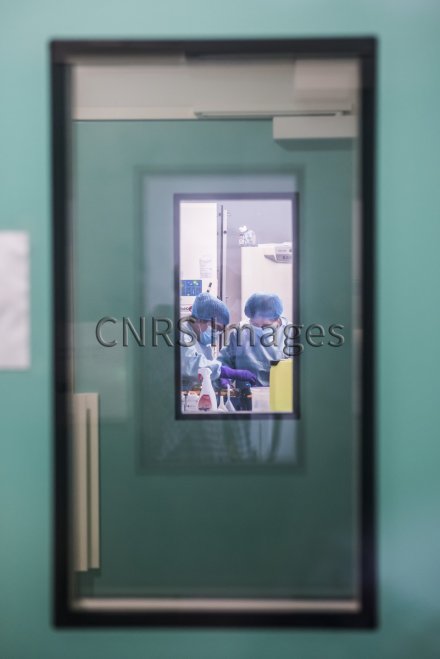Production year
2017

© Hubert RAGUET / Institut Cochin / CNRS Images
20170080_0005
Handling HIV in the P3 laboratory, a contained space for research into level-3 pathogenic agents. Infectious HIV is brought into contact with CD4+ T lymphocytes with or without antibodies in one of 96 wells in a culture plate, and cultured for 36 hours to evaluate the capacity of the antibodies to block infection. The plate containing the antibodies and virus is then centrifuged to separate the culture supernatant from the cells. The cells will be removed from the P3 laboratory for quantification of the virus using immunolabelling and flow cytometry analysis. Sexual transmission of the HIV-1 virus chiefly occurs when infected cells in genital fluids come into contact with the surface of the genital mucosa. Certain individuals with high exposure to the virus (HESN - highly exposed seronegative), but who are seronegative (no specific virus IgGs in the blood), for reasons that are still poorly understood but which are clearly linked to these repeated infectious exposures, have succeeded in showing an HIV-specific immune response in the mucosa in the form of IgA antibodies. These IgAs recognise the surface of the virus and block infection, protecting these HESN subjects from sexual infection. The "Mucosal entry of HIV and mucosal immunity" team led by Morgane Bomsel has set up an IgA combinatorial library using mucosa samples from HESN women. By characterising the specific nature of these IgAs and their antiviral activities at a cellular level, research scientists are aiming to use them either in passive therapy, through the application of locally protective IgAs in the form of a microbicide before sexual intercourse, or in a vaccine that replicates the production of these IgAs that protect the mucosa. A vaccination test in monkeys was found to protect them completely from repeated experimental vaginal infections. This was followed by a phase 1 clinical trial in which the vaccine succeeded in inducing IgA antibodies, shown to protect against the virus during in-vitro tests, in the vaccinated women. A clinical study in humans (women and men) on a larger scale using this same vaccine is currently being prepared.
The use of media visible on the CNRS Images Platform can be granted on request. Any reproduction or representation is forbidden without prior authorization from CNRS Images (except for resources under Creative Commons license).
No modification of an image may be made without the prior consent of CNRS Images.
No use of an image for advertising purposes or distribution to a third party may be made without the prior agreement of CNRS Images.
For more information, please consult our general conditions
2017
Our work is guided by the way scientists question the world around them and we translate their research into images to help people to understand the world better and to awaken their curiosity and wonderment.